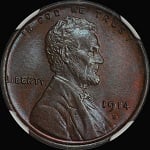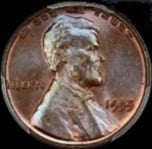Off-Center Clashed Die Indian Cent - My Newest Addition to My Collection
Just got photos back (from Todd at bluccphotos.com) of some new purchases for my personal collection - this is one I'm especially thrilled to own. I bought it in the B&M auction, and here's Rick Snow's write up about how it got the clash:
1880 Indian Cent. Snow-1, FS-101 (FS-009.41). Doubled Die Obverse, Off-Center Clashed Die Reverse. MS-65 BN (PCGS). Eagle Eye Photo Seal.
This is one of the most intriguing varieties known to collectors irrespective of denomination or type. There are clashmarks on the reverse from the obverse die, but instead of being emplaced in the corresponding area they are widely off center. Such is the position of the clashmarks, in fact, that the letters ICA in AMERICA and the surrounding denticles are clearly visible sweeping down through the reverse field between the right wreath and the shield to the letters NE in ONE. One theory as to the cause of this off-center clash is a quick hardness test by the die maker. By smacking the soft die with another die, the impression left would show whether the die was soft enough to accept a digit punch.
The coin itself is fully struck with beautiful glossy-brown surfaces. It has incredible eye appeal as well. The PCGS insert denotes the variety and attribution.
PCGS Population: just 2 in MS-65 BN, and none are finer regardless of color designation.

1880 Indian Cent. Snow-1, FS-101 (FS-009.41). Doubled Die Obverse, Off-Center Clashed Die Reverse. MS-65 BN (PCGS). Eagle Eye Photo Seal.
This is one of the most intriguing varieties known to collectors irrespective of denomination or type. There are clashmarks on the reverse from the obverse die, but instead of being emplaced in the corresponding area they are widely off center. Such is the position of the clashmarks, in fact, that the letters ICA in AMERICA and the surrounding denticles are clearly visible sweeping down through the reverse field between the right wreath and the shield to the letters NE in ONE. One theory as to the cause of this off-center clash is a quick hardness test by the die maker. By smacking the soft die with another die, the impression left would show whether the die was soft enough to accept a digit punch.
The coin itself is fully struck with beautiful glossy-brown surfaces. It has incredible eye appeal as well. The PCGS insert denotes the variety and attribution.
PCGS Population: just 2 in MS-65 BN, and none are finer regardless of color designation.

0



Comments
Sean Reynolds
"Keep in mind that most of what passes as numismatic information is no more than tested opinion at best, and marketing blather at worst. However, I try to choose my words carefully, since I know that you guys are always watching." - Joe O'Connor
Many years ago when I was ANACS Bill Fivaz sent me one and asked me what caused the marks. Took me a while to figure out that they were clash marks from a greatly tilted obverse die. The die was probably fallinbg out of the upper die holder when it came down and impacted the reverse die like this.
TD
We need more quality threads like this one!
Michael Kittle Rare Coins --- 1908-S Indian Head Cent Grading Set --- No. 1 1909 Mint Set --- Kittlecoins on Facebook --- Long Beach Table 448
Are you looking for the other off center clashed reverse dates too??
<< <i>Beautiful example.
Are you looking for the other off center clashed reverse dates too?? >>
For my personal collection, I mainly look for eye appealing uncirculated Indian cents with something unique about them - toning, error, variety, etc. So if you know of/have any other Indian cents such as these, I'd be interested.
The Penny Lady®
<< <i>Took me a while to figure out that they were clash marks from a greatly tilted obverse die. The die was probably fallinbg out of the upper die holder when it came down and impacted the reverse die like this.
TD >>
So you think a tilted obverse die is what caused the off-center clashing, rather than from a quick hardness test as mentioned by Rick Snow? That is an interesting theory and I'd like to hear more about it if you have more info. And if anyone else has some thoughts on how the off-center clashing occurs, please post it.
The Penny Lady®
<< <i>
<< <i>Took me a while to figure out that they were clash marks from a greatly tilted obverse die. The die was probably fallinbg out of the upper die holder when it came down and impacted the reverse die like this.
TD >>
So you think a tilted obverse die is what caused the off-center clashing, rather than from a quick hardness test as mentioned by Rick Snow? That is an interesting theory and I'd like to hear more about it if you have more info. And if anyone else has some thoughts on how the off-center clashing occurs, please post it. >>
Yeah. Imagine if the upper die became loose while the press was running. Perhaps a set screw broke or something. It could fall down at an angle and be jammed against the reverse die with a lot of force. Wherever it hit, it hit.
TGD
The Penny Lady®
TD
<< <i>And, there is no reason to make a huge disfiguring mark on a perfectly usable working die. THe Mint had equipment to perform the contemporary equivalent of a Rockwell Hardness Test, where you smack the surface of a die with a hardened pointed tool and see how large a (tiny) hole it makes. Just leaves a tiny pimple on the coins then struck from that die.
TD >>
This does sound much more plausible, but I'm curious, how did you come by this information?
The Penny Lady®
<< <i>Are there examples in other series of this far off-center clashes? >>
Isn't there a bust half with a row of denticles out in the field?
Now, that being said, I think he clash was done while the die was soft. It could have been smacked with an obverse die by hand to test the hardness. I imagine one die can be used to test for the entire batch that was placed in the furnace. It certianly would be frowned upon since it disfigured the die so much.
The most curious thing is the clash inside the E in ONE. It is much lower in the die than the other clash marks. How did it get there?
BTY, I wanted to have that coin available for my students at Summer Seminar, but it was no longer in inventory.
<< <i>The most curious thing is the clash inside the E in ONE. It is much lower in the die than the other clash marks. How did it get there? >>
I hadn't noticed that before, that is definitely very interesting! What process would have allowed that part to be struck so deeply into the recesses of the E, yet still be stamped on top of the E? As you said, very curious.
<< <i>BTY, I wanted to have that coin available for my students at Summer Seminar, but it was no longer in inventory. >>
Hey, I would certainly have let you borrow it - and would have been happy to "escort" it to your class for you!
The Penny Lady®
I use to own another 65BN (NGC) with similar toning
and made this overlay to help understand how it was struck
by the obverse die.
<< <i>My favorite IH clash of all time, great example you have Penny Lady.
I use to own another 65BN (NGC) with similar toning
and made this overlay to help understand how it was struck
by the obverse die. >>
Thank you. This is overlay very cool, however, shouldn't the overlay coin be obverse down (instead of up)? At least in my coin I believe the clashing on the reverse is from the obverse of the Indian cent facing down - what do you think?
The Penny Lady®
Yes, you have to imagine the die IS facing down and we are looking through it, sort a speak.
Thats why it's inverted to our view.
Imagine the obverse die is translucent so we can see what hit the reverse die.
That's the only way we could see it, from "behind" the die.
It's a mind teaster figuring out the process of these clashes.
Paul
The Penny Lady®